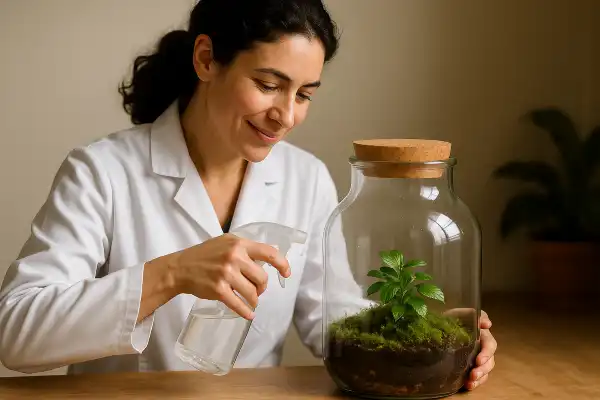Understanding how often should you water a closed terrarium puzzles many plant enthusiasts, especially those new to these miniature ecosystems. The question arises frequently because closed terrariums function differently from traditional houseplants, operating as self-contained environments with their own water cycles.
These glass-enclosed gardens create fascinating micro-worlds that mirror nature’s balance. Last spring, I received a call from a concerned terrarium owner whose pristine moss garden had turned brown overnight—a classic case of watering confusion that many face when transitioning from open plant care to closed ecosystem management.
Our question of June is: Is labradorite safe to use in damp terrariums?
How often should you water a closed terrarium?
Most closed terrariums require watering only every 2-6 months, with many thriving on water additions just 2-4 times per year. This dramatically different schedule compared to houseplants reflects the unique self-sustaining nature of these miniature ecosystems.

The science behind this infrequent watering lies in the closed terrarium’s ability to create its own water cycle. Water evaporates from the soil and plants, condenses on the glass walls, and falls back into the soil, creating a continuous cycle that sustains the plants without constant intervention. This natural recycling system means that once properly established, your terrarium becomes largely self-sufficient.
Reading your terrarium’s water needs
Rather than following a rigid schedule, successful terrarium care requires observing specific visual cues that indicate when watering becomes necessary. The absence of condensation serves as the primary sign that your terrarium needs water, accompanied by symptoms like moss becoming lighter or yellowing, soil losing its brown color, and plants beginning to droop.
A healthy terrarium should show condensation forming on approximately one-third of the glass surface about once daily, typically during warmer periods when the internal water cycle is most active. This condensation pattern indicates that the moisture balance remains optimal and the ecosystem continues functioning properly.
Plants within your terrarium will also communicate their water needs through physical changes. Yellowing leaves or droopy plants signal immediate watering needs, as these symptoms indicate plants are becoming critically dry and beginning to stress. Some sensitive species like Fittonia may completely wilt when dry but typically recover quickly with proper misting.
Proper watering technique for closed systems
The method of water application in closed terrariums differs significantly from traditional plant watering. Using a spray bottle set to “stream” mode, target the interior glass walls rather than spraying directly onto soil or plants, allowing water to run down the sides while rotating 360 degrees to ensure complete coverage.
Start with minimal amounts—approximately two bottle caps of water for jar-sized terrariums, adjusting based on container size. Remember that excess water cannot drain from closed systems like traditional pots, making any added water a permanent part of the ecosystem that must be carefully managed.
Water quality significantly impacts long-term terrarium health. Rainwater provides the ideal choice as it supplies nutrients without disrupting the ecosystem balance, while distilled water serves as an excellent alternative when rainwater isn’t available. Avoid tap water when possible due to chlorine content, which can damage plants and upset the delicate ecosystem balance over time.
Recognizing and correcting water imbalances
Overwatering presents a more common and serious threat than underwatering in closed terrariums. Signs of excessive moisture include constant fogging that prevents viewing plants, water beading on exterior walls, and condensation covering more than one-third of the glass surface. When soil becomes soggy, root rot becomes a serious risk as waterlogged conditions cut off oxygen to root systems, causing roots to turn brown and mushy.
Correcting excess moisture requires patience and careful intervention. Open the lid for 24 hours to allow excess moisture to evaporate, then close and continue monitoring—repeat this process until condensation levels normalize. For severely overwatered systems, use a pipette to remove standing water from the drainage layer at the bottom.
Environmental factors affecting watering frequency
Several environmental conditions influence how often your terrarium requires water additions. Terrarium size, materials used, plant species, and surrounding environmental conditions all impact watering frequency, with regular ventilation increasing water needs.
Temperature fluctuations particularly affect internal moisture levels. Higher temperatures increase plant transpiration rates significantly—at 30°C, plants may transpire three times faster than at 20°C, leading to more rapid moisture cycling and potentially increased watering needs.
The settling period after creation or disturbance also affects watering requirements. During the first few weeks, plants undergo an adaptation phase as they adjust to their closed environment, requiring more careful monitoring and potentially more frequent adjustments to achieve proper moisture balance.
Troubleshooting common watering issues
Understanding normal versus problematic condensation patterns helps maintain optimal conditions. Some condensation during peak sunlight hours is natural and healthy, reflecting active plant transpiration, but constant heavy fogging indicates excessive moisture that requires intervention.
Normal condensation and fogging actually indicate proper ecosystem function and should not be eliminated by opening the terrarium, as this disrupts the natural water cycling that keeps the system self-sustaining. The goal involves achieving balance where some humidity appears on glass surfaces without creating constantly obscured viewing or dripping conditions.
Plant health issues often stem from watering imbalances. Mold growth typically results from excessive humidity combined with poor air circulation, requiring lid removal for several hours and careful moisture reduction. Conversely, plants showing wilted leaves or pale moss coloration indicate insufficient moisture that requires immediate but measured water additions.
Conclusion
Established closed terrariums typically require watering only every 2-3 months, making them remarkably low-maintenance once properly balanced. The key lies in observation rather than schedules—watching for condensation patterns, plant health signals, and soil moisture levels.
Just last month, I adjusted the watering routine for my own collection of vintage apothecary jar terrariums that had been thriving for three years. By carefully observing their subtle cues and respecting their self-sustaining nature, these miniature worlds continue flourishing with minimal intervention. The patience required to master terrarium watering teaches us to work with nature’s rhythms rather than against them, creating more resilient and beautiful ecosystems that reward our careful attention with years of quiet beauty.
El Castor is your exclusive terrarium guide.
